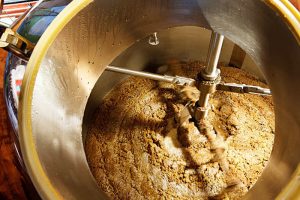
Importance of PH value monitoring in the brewing process
Maintaining an optimal pH level is critical to a successful fermentation process in beer brewing. In this article, we explore the methods and strategies used to adjust and control the pH in fermenters to ensure an ideal environment for the microorganisms and the desired outcome of the fermentation process.

The 500L brewing system has been successfully completed
The 500L brewing system for a customer in Anhui, China has been completed, The 2 tanks 3 vessels brewhouse combination type is popular with customers and is suitable for use in bars or brewpubs. If you have limited space in your room and want to brew multiple batches a day, you can try this type.

What are the common maintenance requirements for beer filling machines?
Beer filling machines are crucial assets in the brewing industry, facilitating the efficient and accurate packaging of beer into bottles or cans. To ensure optimal performance and longevity, regular maintenance is essential.

What are the different types of beer filling machines on the market?
Beer filling machines play a vital role in the brewing industry, ensuring efficient and accurate filling of bottles and cans. With advancements in technology, several types of beer filling machines have emerged in the market. In this article, we will explore the different types of beer filling machines available and their distinct features, helping breweries

The allure of home brewing
In recent years, the art of home brewing has experienced a remarkable recurrence, as beer enthusiasts have embraced the opportunity to create their own handcrafted libations. Home-brewed beer offers a delightful journey into the world of brewing, combining craftsmanship, creativity, and a dash of scientific precision. In this article, we explore the joys and rewards

1000L beer brewing equipment sent to Germany
micet designed the equipment for him according to the client’s request. According to his brewing process, we designed the fermenter with agitator and motor. This type of fermenter is also used for the production of kombucha and more. Previous Next The main configuration of 1000L brewing equipment: 1000L 2 vessels brewhouse: Mash/Lauter tank+Kettle/Whirlpool tank 1500L HLT 12㎡ heat

What factors should a brewery consider when choosing a beer filling machine?
Investing in a beer filling machine is a significant decision for any brewery. Selecting the right equipment is crucial for ensuring efficiency, product quality, and meeting production demands. In this article, we will discuss the key factors that should be considered when choosing a be er filling machine for your brewery, empowering you to make

How do you properly calibrate a temperature controller for fermentation?
Temperature control is a critical aspect of the fermentation process in brewing. To ensure consistent and desirable outcomes, it is essential to accurately calibrate the temperature controller that governs the environment in which the yeast ferments. In this article, we will guide you through the steps of properly calibrating a fermentation temperature controller, empowering you

1000hL beer brewing equipment arrived in Dubai and successfully installed
The customer is very satisfied and pleasantly surprised with the customized 10HL brewing equipment.When you install, our pipes will be marked and provide brewhouse installation and pipe drawings, just need to connect according to the serial number, it is simple. And we have detailed equipment use and maintenance manuals, you can quickly understand the equipment.

What is the purpose of a mash tun in the brewing process?
When it comes to brewing beer, a mash tun is a fundamental piece of equipment that plays a critical role in the creation of that delicious beverage we all love. In this article, we will delve into the purpose of a mash tun and explore its significance in the brewing process. So, grab a pint and let’s dive in!
Learn more about winemaking
If you want to learn more about winemaking, you can subscribe to our blog for updates. We will update the blog every week so that you can learn more about winemaking.
